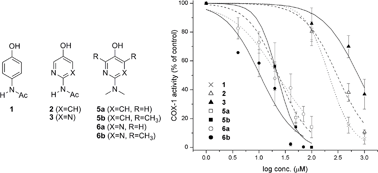Pyridine and pyrimidine analogs of acetaminophen as inhibitors of lipid peroxidation and cyclooxygenase and lipoxygenase catalysis†
Abstract
Herein we report an investigation of the efficacy of

* Corresponding authors
a Department of Chemistry, Vanderbilt University, Nashville, TN, USA
b Department of Chemistry, Queen's University, Kingston, Ontario, Canada
c Division of Clinical Pharmacology, Vanderbilt University School of Medicine, Nashville, TN, USA
d Departimento di Chimica Organica “A. Mangini”, Università di Bologna, via San Giacomo 11, Bologna, Italy
Herein we report an investigation of the efficacy of

 Please wait while we load your content...
Something went wrong. Try again?
Please wait while we load your content...
Something went wrong. Try again?
T. Nam, S. J. Nara, I. Zagol-Ikapitte, T. Cooper, L. Valgimigli, J. A. Oates, N. A. Porter, O. Boutaud and D. A. Pratt, Org. Biomol. Chem., 2009, 7, 5103 DOI: 10.1039/B912528K
To request permission to reproduce material from this article, please go to the Copyright Clearance Center request page.
If you are an author contributing to an RSC publication, you do not need to request permission provided correct acknowledgement is given.
If you are the author of this article, you do not need to request permission to reproduce figures and diagrams provided correct acknowledgement is given. If you want to reproduce the whole article in a third-party publication (excluding your thesis/dissertation for which permission is not required) please go to the Copyright Clearance Center request page.
Read more about how to correctly acknowledge RSC content.
 Fetching data from CrossRef.
Fetching data from CrossRef.
This may take some time to load.
Loading related content
